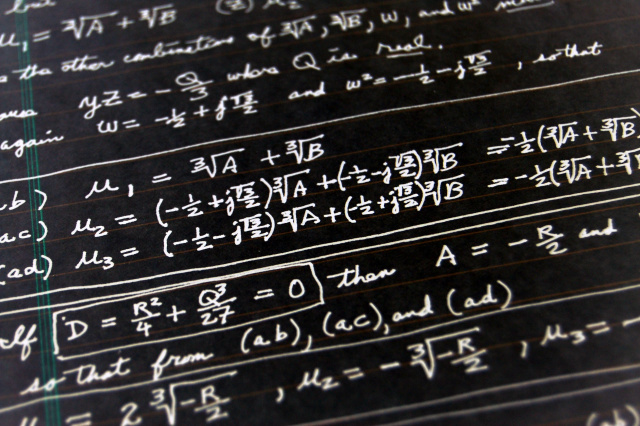Everyone needs to know the mechanical methods of paper-and-pencil arithmetic. The technical term for these methods is algorithm. Much of high school and college algebra, and even calculus, is similarly algorithmic.
Math teachers at every level intend to teach their students to understand the mathematics behind the algorithms so the students can apply the algorithms properly, correctly and creatively.
That mission doesn’t always succeed, but when it does it’s often the teacher, not the curriculum program, that makes the difference.
That being said, here’s 60 years of sample programs – grade school, high school, community college and university – that worked or, mostly, failed.
New math
Harvard professor Andy Gleason was one of the guiding lights of the School Mathematics Study Group (SMSG), which produced the innovations of the 1950s called “new math.”
Here, the idea was not to hide the structure of grade school arithmetic behind the mechanical methods but to explicitly put the mathematics in front of the students. For example:
If 17 is regarded as a polynomial in 10, namely 1 times 10 to the 1 plus 7 times 10 to the zero, and 22 is regarded as 2 times 10 to the 1 plus 2 times 10 to the zero, then polynomial multiplication and collecting terms gives the product 3 times 10 to the second plus 7 times 10 to the first plus 4 times 10 to the zero, or 374, thereby decoding the multiplication algorithm.
New math failed in the sense that its adoptions of the late ’50s were abandoned by the late ’60s. On the other hand, those lucky enough to be taught from new math materials by teachers who knew what they were doing, such as we members of the class of 1962 at Chickasha High School, benefited immeasurably.
Continuous review
In standard algebra texts, you study a topic in a section, the end of the section poses some homework problems, and then you move on to a new topic in the next section with homework problems on the new topic.
But former Oklahoma junior-college algebra teacher John Saxon had an idea for improving algebra instruction. Saxon’s idea was to include some homework problems in every section that used the topics of previous sections, a scheme he called continuous review.
Granted, continuous review is a good idea, but it’s only necessary if algebra is regarded as a collection of unfathomable rules (which is what Saxon thought). The alternative is to understand the algorithm, in which case algebra is logical and natural. Example: You can treat the quadratic formula as memorizing a formula or as a simple consequence of completing the square.
Compounding the fundamental flaw in continuous review’s approach is the fact that continuous review can be incorporated in any math book, so Saxon’s idea was vulnerable to easy imitation.
Reform calculus
Because it’s the largest of the true college-level mathematics courses, calculus has been the target of much math education interest. College-level instruction shares similar concerns with pre-college mathematics, such as student understanding, practical application and pedagogy.
In the 1980s and ’90s, mathematicians began to consider whether it was better, or even possible, to try to teach calculus using functions described only by data, or even by graphs of data. The availability of graphing calculators and, later, laptops and tablets made it possible; whether it was better was addressed by trying some samples to see.
The National Science Foundation (NSF) invested some money in some groups who created textbooks that tried presenting calculus in this new way. They termed it “reform calculus.”
A consortium of 12 authors from eight institutions prepared one of the larger NSF calculus reform projects with administrative headquarters at Harvard, and their book became known as Harvard Calculus. The provenance and title, of course, had an obvious cachet that the publisher who printed the preliminary versions of the book was not immune to exploiting.
It also had the unfortunate effect of attracting concern about the lack of mathematical precision of the materials that was not directed at materials coming, for example, from the St. Olaf College math department. (Lack of mathematical precision was an essential feature of the pedagogy of all the reform calculus texts.)
Calculus reform also failed. By the early aughts, institutions, including the University of Oklahoma, were back teaching using the textbooks they had used before the reform programs started. Although the textbooks now include the innovations that calculus reform had brought about, these are just additional sections in already bloated books, easy enough to skip if the instructor so chooses, and most do.
I looked on Amazon recently to see if the Harvard Calculus book is available, and good news: It is, in its sixth edition. Although now called simply Calculus, the bad news is that it costs as much as its competitors despite having been created with a federal grant. Worse news is that the student purchasers who review it despise it. Wrote one reviewer from 2010: “It is, by far, the worst calculus book I have ever used. Most math books are not particularly user-friendly, but this one is truly terrible. ”
Ending the math wars
All of these programs that got caught up in the math wars, and others, had their passionate partisans and opponents. Meanwhile, common sense should tell us that you can’t learn to understand something you can’t do, and also that it’s better to understand what you are doing than to not understand it. Most of the heated arguments about proper mathematics curriculum standards – what some have called math wars – comes down to denying one of these obvious truisms.
It’s time to stop that.

















